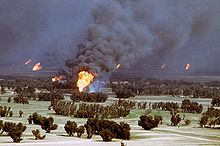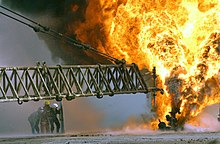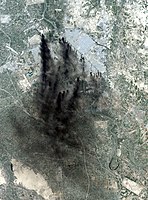Kuwait is a sovereign state in Western Asia located at the head of the Persian Gulf. The geographical region of Kuwait has been occupied by humans since antiquity, particularly due to its strategic location at the head of the Persian Gulf. In the pre-oil era, Kuwait was a regional trade port. In the modern era, Kuwait is best known for the Gulf War (1990–1991).

Nuclear winter is a severe and prolonged global climatic cooling effect that is hypothesized to occur after widespread firestorms following a large-scale nuclear war. The hypothesis is based on the fact that such fires can inject soot into the stratosphere, where it can block some direct sunlight from reaching the surface of the Earth. It is speculated that the resulting cooling would lead to widespread crop failure and famine. When developing computer models of nuclear-winter scenarios, researchers use the conventional bombing of Hamburg, and the Hiroshima firestorm in World War II as example cases where soot might have been injected into the stratosphere, alongside modern observations of natural, large-area wildfire-firestorms.

The Kingdom of Saudi Arabia is a country situated in West Asia, the largest country on the Arabian Peninsula, bordering the Persian Gulf and the Red Sea. Its extensive coastlines provide great leverage on shipping through the Persian Gulf and the Suez Canal. The kingdom occupies 80% of the Arabian Peninsula. Most of the country's boundaries with the United Arab Emirates (UAE), Oman, and the Republic of Yemen are undefined, so the exact size of the country remains unknown. The Saudi government estimate is at 2,217,949 square kilometres, while other reputable estimates vary between 2,149,690 and 2,240,000 sq. kilometres. Less than 7% of the total area is suitable for cultivation, and in the early 1960s, population distribution varied greatly among the towns of the eastern and western coastal areas, the densely populated interior oases, and the vast, almost empty deserts.
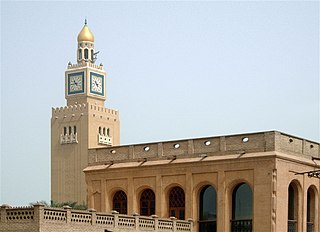
Kuwait City is the capital and largest city of Kuwait. Located at the heart of the country on the south shore of Kuwait Bay on the Arabian Gulf, it is the political, cultural and economic centre of the emirate, containing Kuwait's Seif Palace, government offices, and the headquarters of most Kuwaiti corporations and banks. It is one of the hottest cities in summer on earth, with average summer high temperatures over 45 °C (113 °F) for three months of the year.

An oil spill is the release of a liquid petroleum hydrocarbon into the environment, especially the marine ecosystem, due to human activity, and is a form of pollution. The term is usually given to marine oil spills, where oil is released into the ocean or coastal waters, but spills may also occur on land. Oil spills may be due to releases of crude oil from tankers, offshore platforms, drilling rigs and wells, as well as spills of refined petroleum products and their by-products, heavier fuels used by large ships such as bunker fuel, or the spill of any oily refuse or waste oil.

The Gulf War was an armed conflict between Iraq and a 42-country coalition led by the United States. The coalition's efforts against Iraq were carried out in two key phases: Operation Desert Shield, which marked the military buildup from August 1990 to January 1991; and Operation Desert Storm, which began with the aerial bombing campaign against Iraq on 17 January 1991 and came to a close with the American-led liberation of Kuwait on 28 February 1991.

The Burgan field is an oil field situated in the desert of southeastern Kuwait. Burgan field can also refer to the Greater Burgan—a group of three closely spaced fields, which includes Burgan field itself as well as the much smaller Magwa and Ahmadi fields. Greater Burgan is the world's largest sandstone oil field, and the second-largest overall, after Ghawar. The Burgan Field is located on the coast of the Persian Gulf which played a huge part in the creation of this prominent reservoir formation many million years ago.
The 1990 oil price shock occurred in response to the Iraqi invasion of Kuwait on August 2, 1990, Saddam Hussein's second invasion of a fellow OPEC member. Lasting only nine months, the price spike was less extreme and of shorter duration than the previous oil crises of 1973–1974 and 1979–1980, but the spike still contributed to the recession of the early 1990s in the United States. The average monthly price of oil rose from $17 per barrel in July to $36 per barrel in October. As the U.S.-led coalition experienced military success against Iraqi forces, concerns about long-term supply shortages eased and prices began to fall.
The Rumaila oil field is a super-giant oil field located in southern Iraq, approximately 50km to the south west of Basra City. Discovered in 1953 by the Basrah Petroleum Company (BPC), an associate company of the Iraq Petroleum Company (IPC), the field is estimated to contain 17 billion barrels, which accounts for 12% of Iraq's oil reserves, estimated at 143 billion barrels. Rumaila is said to be the largest oilfield ever discovered in Iraq and is one of the three largest oil fields in the world.

The Gulf War oil spill, or the "Persian Gulf oil spill", was one of the largest oil spills in history, resulting from the Gulf War in 1991. In January 1991, Iraqi forces allegedly began dumping oil into the Persian Gulf to stop a U.S. coalition-led water landing on their shores. Despite quite high initial estimates, the spill likely was about 4,000,000 US barrels. Within the following months of the spill, most clean-up was targeted at recovering oil, and very little clean-up was done on Saudi Arabia’s highly-affected beaches. An initial study in 1993 found that the spill will not have long-term environmental consequences, but many studies since 1991 have concluded the opposite, claiming that the spill is responsible for environmental damage to coastline sediments and marine species and ecosystems. Considered an act of environmental terrorism, the spill was a heated political move that had implications for the larger Gulf War and temporarily damaged Kuwait and Saudi Arabia.

Ixtoc 1 was an exploratory oil well being drilled by the semi-submersible drilling rig Sedco 135 in the Bay of Campeche of the Gulf of Mexico, about 100 km (62 mi) northwest of Ciudad del Carmen, Campeche in waters 50 m (164 ft) deep. On 3 June 1979, the well suffered a blowout resulting in the largest oil spill in history at its time. To-date, it remains the second largest oil spill in history after the Deepwater Horizon oil spill.

The Iraqi invasion of Kuwait began on 2 August 1990 and marked the beginning of the Gulf War. After defeating the State of Kuwait on 4 August 1990, Iraq went on to militarily occupy the country for the next seven months. The invasion was condemned internationally, and the United Nations Security Council (UNSC) adopted numerous resolutions urging Iraq to withdraw from Kuwaiti territory. The Iraqi military, however, continued to occupy Kuwait and defied all orders by the UNSC. After initially establishing the "Republic of Kuwait" as a puppet state, Iraq annexed the entire country on 28 August 1990; northern Kuwait became the Saddamiyat al-Mitla' District and was merged into the existing Basra Governorate, while southern Kuwait was carved out as the all-new Kuwait Governorate. By November 1990, the adoption of UNSC Resolution 678 officially issued Iraq an ultimatum to withdraw unconditionally by 15 January 1991 or else be removed by "all necessary means" from Kuwaiti territory. In anticipation of a war with Iraq, the UNSC authorized the assembly of an American-led military coalition.
The United Nations Compensation Commission (UNCC) was created in 1991 as a subsidiary organ of the United Nations Security Council. Its mandate was to process claims and pay compensation for losses and damage suffered as a direct result of Iraq's 1990–1991 invasion and occupation of Kuwait which started the Gulf War. These losses included claims for loss of property, deaths, loss of natural resources, damage to public health and environmental damage. The work of the UNCC officially came to a close at the end of 2022.
The aftermath of Gulf War saw drastic and profoundly significant political, cultural, and social change across the Middle East and even in areas outside those that were directly involved.

A blowout is the uncontrolled release of crude oil and/or natural gas from an oil well or gas well after pressure control systems have failed. Modern wells have blowout preventers intended to prevent such an occurrence. An accidental spark during a blowout can lead to a catastrophic oil or gas fire.

Oil well fires are oil or gas wells that have caught on fire and burn. They can be the result of accidents, arson, or natural events, such as lightning. They can exist on a small scale, such as an oil field spill catching fire, or on a huge scale, as in geyser-like jets of flames from ignited high pressure wells. A frequent cause of a well fire is a high-pressure blowout during drilling operations.
This is a list of notable events relating to the environment in 1991. They relate to environmental law, conservation, environmentalism and environmental issues.
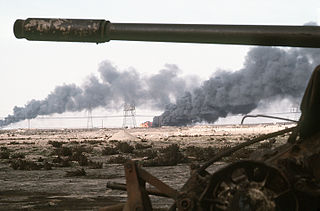
The 1991 Gulf War and the 2003 Iraq War brought about a significant negative impact on the environment. Indeed, Persian Gulf countries, especially Kuwait and Iraq, faced serious environmental disasters after the wars.

Located in the Middle East, Kuwait is a relatively small country that has been the center of many political and economic issues over the past few decades. Stemming from these tensions, Kuwait as well as other countries in the region, including Iran, Iraq, and Qatar face threats from environmental issues. A loss of agriculture due to climate change, pollution from the country's oil industry and Oil Fires of 1991 as well as damages to agriculture and biodiversity are just some of the common environmental issues. The Kuwaiti government has worked to mitigate and adapt to these issues through policy and the creation of agencies to research, educated and inform about environmental problems, their sources, and their effects.

The Arabian-Persian Gulf Coastal Plain Desert ecoregion covers the desert coastal plain of the northwest Persian Gulf, that is, on the northeast Arabian Peninsula, from Kuwait in the north to a small coastal sector in the United Arab Emirates to the southeast.





